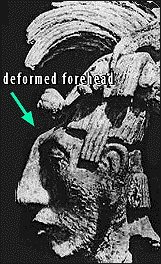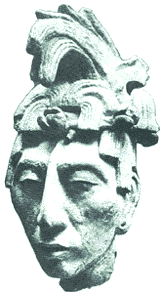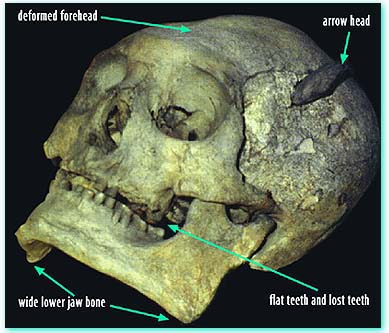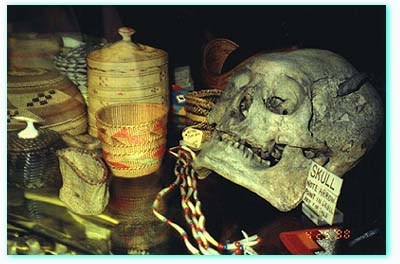|
It's rare enough to find a real human skull among the knickknacks, let alone one that was so unusual. The skull was allegedly found with the arrowhead depicted here embedded in the parietal area of the skull and this injury is the presumed cause of death. The teeth are flat and the dental condition is poor. This suggests a diet of stone ground grain, of which the particles of stone were inseparable from the food. The extra wide jaw and the obvious bony ridge that runs from the top of the nose to the middle of the sloped and deformed forehead are what makes this an unusual find.
Considering the Anasazi were no more than 42 inches tall, while other Native American cultures, simultaneously, enjoyed almost twice that height, there is now reason to question the present theories of a Bering Straits migration alone. There seems to quite a diverse gene pool and cultural style in early American history, suggesting a tradition of being a cultural "melting pot."
by Lee M.
The top picture was taken through a glass case at Ye Olde Curiosity Shoppe on the waterfront of Seattle. It has a stone arrowhead embedded in it, but what caught my attention was the lower jaw, the mandible.
On the right and below is a side view of a Terra Cotta bust taken from the Tomb of Pacal at Palenque, Mexico.
There is also the front view of the same bust. Note the nose bridge (and it is a nose bridge) that runs up the forehead.
Pacal grabbed a lot of attention from Van Daniken because he depicted the Sarcophagus lid as that of an astronaut. The sarcophagus is 13' x 7' wide. Now check out the interior of the sarcophagus and note the shape of it (rocket ship like) and estimate the size of the skeleton leaving about 18 inches for the walls of the sarcophagus.
I would bring something else to your
attention: Source book Project (Po Box 107, Glen Arm, MD 21027) has reprints of Smithsonian Publications of the 19th Century. For Instance, Explorations of the Aboriginal Remains of Tennessee by Joseph Jones (for the Smithsonian) as well as Ancient Monuments of the Mississippi Valley.
|
|
But let me quote a bit from America's Fascinating Indian Heritage, Readers Digest, 1978, page 35.
|

|
 |
There has, been some "revisionism" as regards the assessment of these people, but I suspect it is socio-political motivated, in any event gauging by the effigy pipes and the skulls they left behind they were not "Caucasians" as some early explorers presumed them to be.
The interesting thing though is his measurement and description of the bones he unearthed, men over 6 ft tall, massively boned, deformed heads, and one gent he called "fang" at 7' in height. What struck me though was his description of the mandible, the lower jaw, and it was after I read his book, that I encountered the skull in Seattle and took the photo, because it is indicative that perhaps the Mississippi Valley was populated by a different species or subspecies of humans.
|
Of course the idea of other species of humans, or even of migrations of peoples other than that sanctioned by the current narrative (biologists, anthropologists, archaeologists) doesn't sit well, as it might be offensive to some folk, especially those whose careers and reputations are already heavily invested in the current narrative.
 DNA tests could put a lot of speculation to rest, and I suspect that such test have been performed, but the results, if unsettling, seem not to have filtered out to the general population. For instance, I've seen a report of DNA testing in South America, and it appears that the indigenous peoples are more related to the people of South East Asia, a long haul and a far cry from any Bering-land-bridge. Raising the question of why folk in the tropics, would even migrate north to Ice, cold and glaciers during or immediately after an ice age.
|

Other unexplained photos on this site:
If you have a suggestion or a photo to submit, send it to:
Editor/viewzone.com
myristicin@hotmail.com
